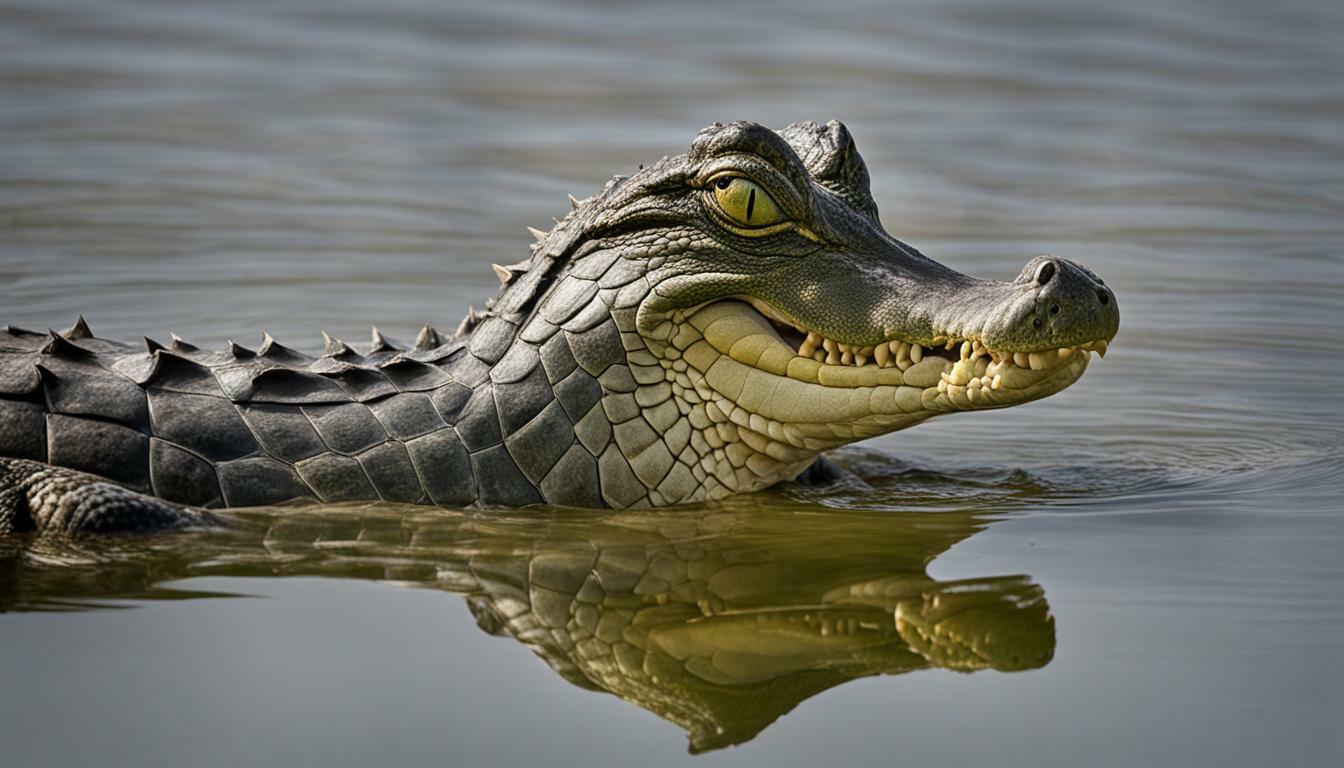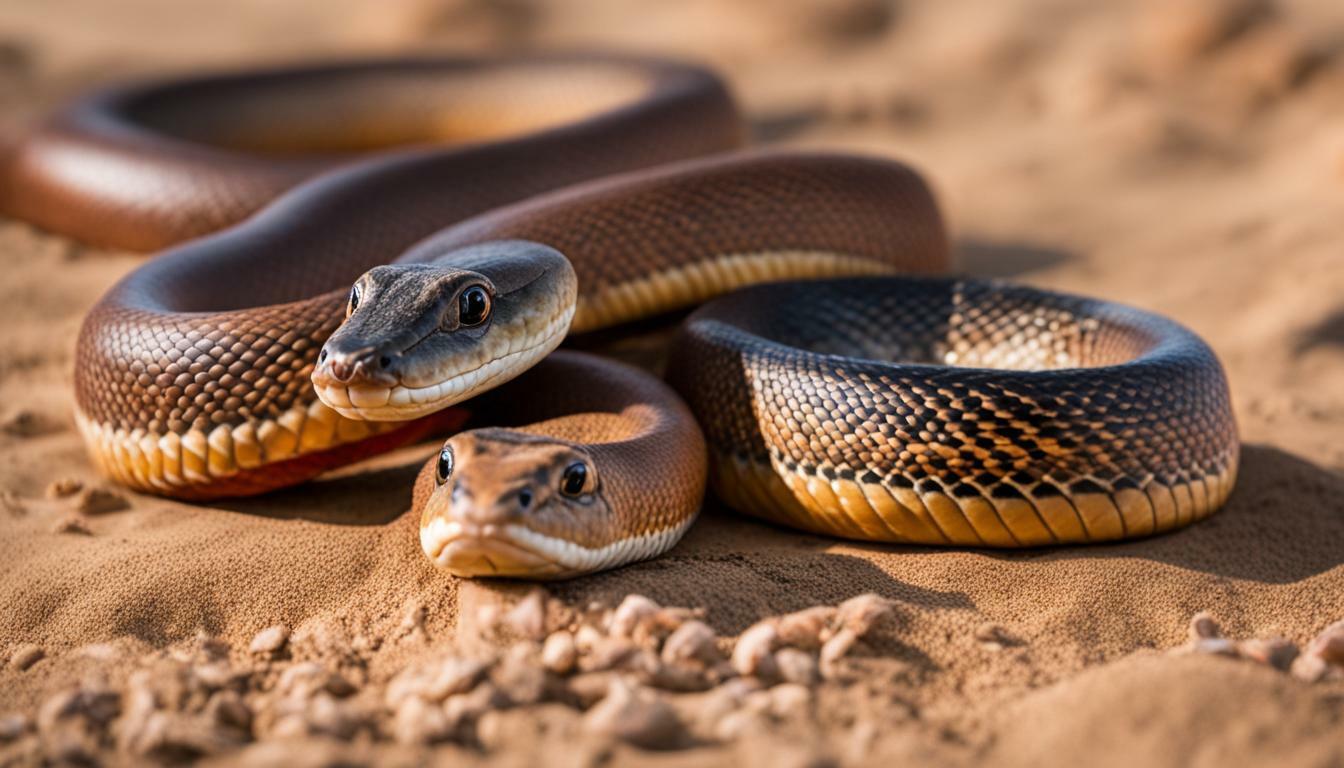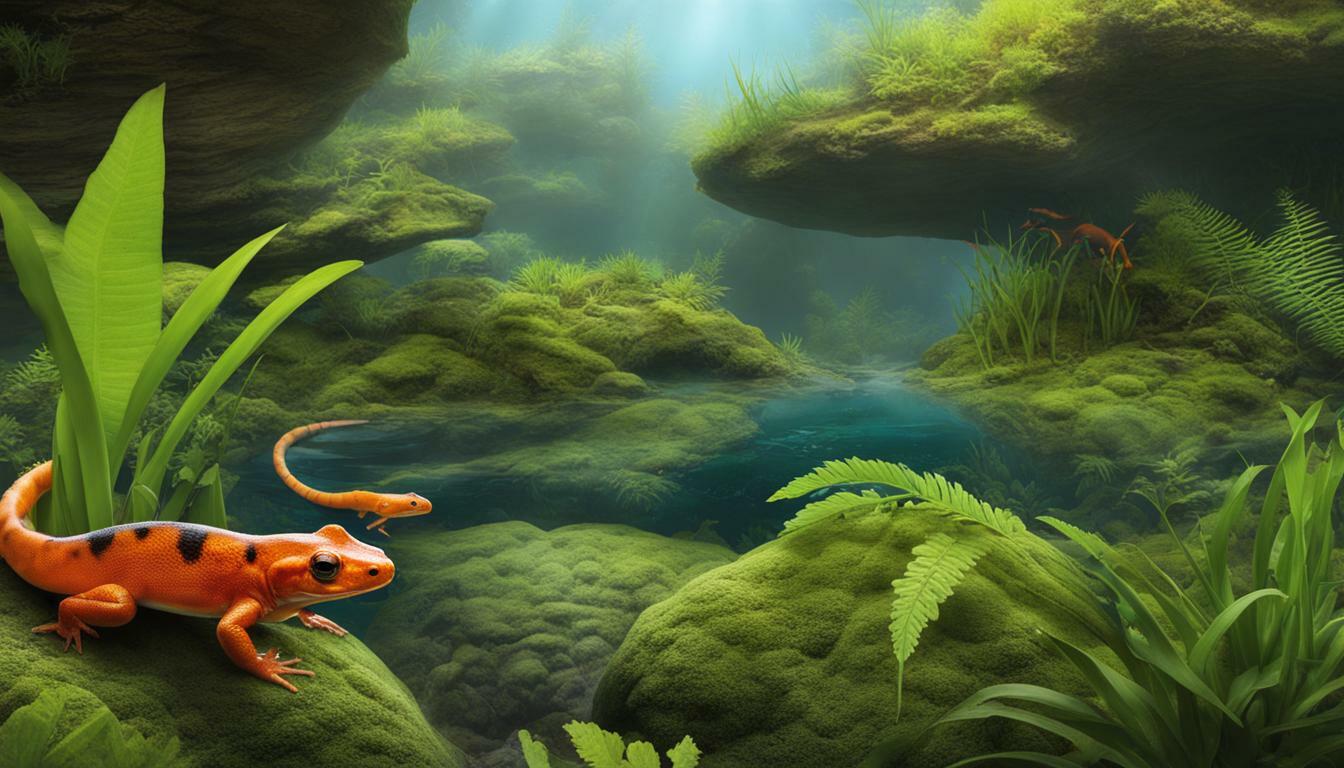Caimans and gharials are two distinct species of crocodilians, each with their own unique characteristics. While they may appear similar at first glance, there are several key differences that set them apart. Let’s explore these differences to gain a better understanding of these fascinating reptiles.
One of the main physical differences between caimans and gharials is their snout shape. Caimans have a shorter U-shaped snout, while gharials have a long and thin snout, better suited for catching fish sideways. This difference in snout shape plays a crucial role in their hunting techniques and prey preferences.
In addition to snout shape, there are differences in teeth and jaw structure between caimans and gharials. Caimans have longer and sharper teeth compared to gharials, enabling them to efficiently capture and subdue their prey. These teeth and jaw differences contribute to their unique hunting styles and feeding habits.
Movement and behavior also vary between caimans and gharials. Caimans, similar to crocodiles, are known for their agile and quick movements. On the other hand, gharials exhibit movements that are more reminiscent of crocodiles, showcasing a distinctive swimming style.
Another aspect where caimans and gharials differ is in their habitat and adaptability. While both species are highly adaptable, caimans thrive in a wider range of environments, including rivers, lakes, and wetlands, whereas gharials are predominantly found in riverine habitats.
Diet and prey preferences are also notable areas of difference between caimans and gharials. Caimans have a broader diet, consuming a variety of prey such as fish, birds, and mammals. Gharials, on the other hand, primarily feed on fish, utilizing their slender snout to effectively catch their aquatic prey.
Last but not least, there are significant differences in size and growth patterns between caimans and gharials. Caimans tend to be smaller in size compared to gharials, with differing growth rates and overall body dimensions.
Overall, caimans and gharials may share certain similarities as crocodilian species, but their distinct physical characteristics, movements, habitats, diets, and sizes set them apart. Understanding these differences helps us appreciate the diverse nature of the reptile world and the remarkable adaptations that enable these creatures to thrive in their respective environments.
Key Takeaways:
- Caimans have a U-shaped snout, while gharials possess a long and thin snout better suited for catching fish sideways.
- Caimans have longer and sharper teeth compared to gharials.
- Caimans exhibit agile movements similar to crocodiles, while gharials have a more crocodile-like swimming style.
- Caimans are adaptable to a wider range of habitats, while gharials are primarily found in riverine environments.
- Caimans have a broader diet, including fish, birds, and mammals, while gharials primarily feed on fish.
- Caimans tend to be smaller in size compared to gharials.
Physical Differences in Snout Shape
One of the key distinctions between caimans and gharials lies in the shape of their snouts. Caimans have a shorter U-shaped snout, while gharials possess a long and thin snout called a gavial. This unique snout shape is an adaptation suited for their respective hunting methods.
Unlike caimans, gharials use their narrow snouts to their advantage when hunting for fish. The elongated shape allows them to glide effortlessly through the water, minimizing hydrodynamic resistance. Their specialized snout design, along with sensory pits on the tip, enables them to detect movement and vibrations caused by fish swimming nearby.
The snout shape of caimans, on the other hand, allows for a different hunting strategy. With a broader and more robust snout, caimans are adept at catching a wider variety of prey items, including small mammals and reptiles. The U-shaped snout provides more room for powerful muscles that aid in capturing and immobilizing their prey.
To summarize, caimans have a shorter and wider snout, which grants them strength and versatility in hunting, while gharials possess a slender and elongated snout, ideal for capturing fish swiftly and efficiently.
| Caimans | Gharials | |
|---|---|---|
| Snout Shape | Short and U-shaped | Long and thin (gavial) |
| Hunting Adaptation | Versatile for various prey items | Specialized for catching fish |
Teeth and Jaw Differences
In addition to their snout shape, caimans and gharials also exhibit variance in their teeth and jaw characteristics. These distinctions play a crucial role in their feeding habits and prey preferences. Caimans, being a sub-species of alligators, have longer and sharper teeth compared to gharials. This dental arrangement enables caimans to efficiently snap and slice through their prey, which primarily consists of fish, birds, and smaller mammals.
Gharials, on the other hand, possess a unique set of teeth and jaw structure that aligns with their specialized diet of primarily fish. Their long and narrow snout, known as a gavial, is lined with numerous interlocking teeth, resembling the shape of a comb. This design allows gharials to trap fish more effectively, as their teeth prevent the escape of slippery prey. While both caimans and gharials are formidable predators, their teeth and jaw structures have evolved to suit their preferred hunting techniques and prey items.
It is important to note that despite these differences, both caimans and gharials share common features with other members of the crocodilian order. Their jaws are incredibly powerful, capable of delivering a forceful bite that can instantly incapacitate their prey. Additionally, the teeth of both species are continuously replaced throughout their lives, ensuring optimal functionality for hunting and feeding.
| Characteristics | Caimans | Gharials |
|---|---|---|
| Snout Shape | Short and U-shaped | Long and thin (gavial) |
| Teeth | Long and sharp | Interlocking comb-like teeth |
| Prey | Fish, birds, smaller mammals | Primarily fish |
Overall, the differences in teeth and jaw characteristics between caimans and gharials reflect their unique adaptations to their respective environments and diets. These variations contribute to the overall diversity within the crocodilian order and showcase the remarkable evolutionary process that has shaped these formidable reptiles.
Differences in Movement and Behavior
While both caimans and gharials belong to the same order, their movement and behavior demonstrate notable disparities. Caimans, which are a sub-species of alligators, exhibit agile movements similar to crocodiles and alligators. Their powerful tails allow them to swiftly navigate through water, making them formidable predators. Caimans are known for their ability to quickly ambush prey, using their sharp teeth to seize and overpower their victims. These reptiles are highly adaptable and can thrive in various aquatic habitats, from rivers and lakes to swamps and wetlands. Caimans are opportunistic hunters, feeding on a wide range of prey, including fish, birds, and mammals.
In contrast, gharials possess a unique and distinct way of moving and behaving. Gharials have a slender and elongated snout called a gavial, which enables them to catch fish sideways. This specialized snout, combined with their strong and streamlined body, allows gharials to swiftly glide through water, making them exceptionally suited for catching fast-moving fish. Unlike caimans, gharials have a more crocodile-like movement, often seen lazily drifting in the water with only their eyes and nostrils exposed, waiting patiently for unsuspecting prey to come within reach. Their specialized snout and behavior highlight their adaptation to a specific diet and environment.
In summary, caimans and gharials, despite belonging to the same order of crocodilians, display distinct differences in movement and behavior. Caimans exhibit agile movements and are opportunistic hunters, while gharials utilize their unique snout and more sedentary behavior to catch fish. These variations highlight the diverse adaptations within the crocodilian family, allowing these reptiles to thrive in their respective habitats.
| Caimans | Gharials |
|---|---|
| Agile movements similar to crocodiles and alligators | Slender and elongated snout used to catch fish sideways |
| Swiftly navigate through water with powerful tails | Swift gliding through water with streamlined body |
| Opportunistic hunters with sharp teeth | Patience in waiting for prey to come within reach |
| Adaptable to various aquatic habitats | Specialized adaptation to specific diet and environment |
Habitat and Adaptability
Caimans and gharials have evolved to thrive in distinct habitats, allowing them to adapt to their respective environments. Caimans, being a sub-species of alligators, are primarily found in Central and South America. They inhabit a variety of freshwater habitats, including rivers, lakes, swamps, and marshes. Caimans have the ability to tolerate both freshwater and brackish water, which gives them an advantage in different types of environments. They are well-adapted to the warm tropical climate of their native habitats.
Gharials, on the other hand, are native to the Indian subcontinent and are primarily found in the rivers and lakes of India, Nepal, and Bangladesh. They are highly adapted to living in flowing freshwater habitats, preferring large rivers with sandy or gravelly bottoms. Gharials have long, slender snouts that allow them to navigate swiftly through the water and catch fish. Their unique snout shape is an adaptation to their specific habitat and feeding behavior.
Habitat Comparison
| Caimans | Gharials |
|---|---|
| Central and South America | Indian subcontinent |
| Rivers, lakes, swamps, and marshes | Large rivers with sandy or gravelly bottoms |
| Can tolerate freshwater and brackish water | Prefer flowing freshwater habitats |
In conclusion, caimans and gharials have evolved to adapt to their specific habitats, allowing them to thrive in their respective environments. Caimans are well-suited to the freshwater habitats of Central and South America, while gharials have specialized adaptations for living in the flowing rivers of the Indian subcontinent. Understanding the unique habitat requirements of these reptiles is crucial for their conservation and management.
Diet and Prey Preferences
The feeding habits and prey choices of caimans and gharials vary significantly. As carnivorous reptiles, both species have adapted to their environments and developed unique strategies for hunting and obtaining food.
Caimans, being a sub-species of alligators, have a diverse diet that includes fish, birds, mammals, and even other reptiles. With their strong jaws and sharp teeth, caimans are powerful predators capable of taking down prey larger than themselves. They are opportunistic hunters, often ambushing their prey by lurking near the water’s edge and launching surprise attacks. Caimans are skilled at swimming and diving, which allows them to catch fish and amphibians both below and above the water’s surface.
Gharials, on the other hand, have a more specialized diet consisting primarily of fish. Their long and thin snouts, equipped with interlocking sharp teeth, are perfectly adapted for catching fish in fast-flowing rivers. Gharials use their snouts as fishing nets, swiftly gliding through the water with their mouths wide open to catch unsuspecting prey. They are known for their patient and stealthy hunting techniques, remaining motionless for long periods until the perfect moment to strike.
It is important to note that while caimans and gharials have different prey preferences, their diets may also overlap in certain areas. As their habitats intersect, competition for food and resources may occur between these two crocodilian species. However, their distinct physical characteristics and hunting strategies allow them to coexist and thrive in their respective environments.
| Caimans | Gharials |
|---|---|
| Fish, birds, mammals, reptiles | Primarily fish |
| Ambush hunting, swimming, diving | Stealthy fishing, gliding |
| Powerful jaws, sharp teeth | Long and thin snout, interlocking teeth |
“Caimans and gharials showcase fascinating adaptations in their diets and hunting techniques. While caimans are versatile predators capable of hunting a wide range of prey, gharials have evolved to be highly specialized fish hunters. Both species have found their niche in their respective habitats, showcasing the diversity and resilience of crocodilians as a whole.” – Wildlife Expert
Size and Growth Differences
Caimans and gharials exhibit distinct variations in size, with notable differences in their growth rates. Caimans, which belong to the alligator family, tend to be smaller compared to gharials, which are part of the crocodile family. Adult caimans typically reach lengths of 4 to 8 feet, while gharials can grow up to an impressive 15 to 20 feet. The size difference between the two species can be attributed to their respective habitats and ecological roles. Caimans are often found in smaller bodies of water like rivers and swamps, where their smaller size allows for greater maneuverability and hunting efficiency. Gharials, on the other hand, inhabit larger rivers and estuaries, where their larger size helps them catch larger prey and compete with other apex predators.
When it comes to growth rates, caimans tend to mature at a faster pace compared to gharials. Caimans typically reach sexual maturity between 3 to 6 years of age, while gharials may take up to 10 to 12 years to reach reproductive maturity. This difference in growth rates can be attributed to various factors, including genetic predispositions and environmental conditions. Caimans have a higher metabolic rate, allowing them to grow and develop more quickly. Gharials, being specialized fish-eaters, may take longer to reach maturity due to their reliance on a specific diet and slower growth rates associated with obtaining sufficient nutrition from fish.
It is important to note that these size and growth differences can vary within individual species and populations, depending on factors such as geographical location and availability of resources. Furthermore, both caimans and gharials are threatened by habitat loss and conservation challenges, which can impact their size and growth patterns. Understanding these variations in size and growth rates contributes to our knowledge of these fascinating reptiles and aids in their conservation efforts.
| Caimans | Gharials | |
|---|---|---|
| Adult Length | 4 to 8 feet | 15 to 20 feet |
| Age of Sexual Maturity | 3 to 6 years | 10 to 12 years |
Conclusion
In conclusion, caimans and gharials are unique species of crocodilians, each possessing their own distinct characteristics and adaptations. Caimans, which are a sub-species of alligators, have a shorter U-shaped snout and longer, sharper teeth. They exhibit agile movements similar to crocodiles. Gharials, on the other hand, have a long and thin snout called a gavial, which is specialized for catching fish sideways. Their movements resemble those of crocodiles as well.
These reptiles have evolved to adapt to their specific habitats and environments, which range from wetlands and rivers to lakes and swamps. They are highly adaptable and have managed to survive for millions of years, even outlasting the dinosaurs. With their scaly skin, strong tails, and large teeth-filled jaws, they sit at the top of the world’s predator list.
Crocodilians, including caimans and gharials, are carnivorous predators with a diverse diet. They feed on insects, fish, birds, and mammals, employing various hunting strategies such as ambush hunting and stalking. Female crocodilians lay eggs, and the temperature of the nest can determine the sex of the offspring. The mother provides protection to her young and assists them in reaching water after hatching. Young crocodilians often stay with their mother or family for a certain period before becoming independent.
FAQ
What is the difference between caimans and gharials?
Caimans and gharials are both species of crocodilians. The main difference lies in their snout shape, with caimans having a shorter U-shaped snout and gharials sporting a long and thin snout.
Are caimans a type of alligator?
Yes, caimans are a sub-species of alligators, belonging to the crocodilian order.
How do caimans and gharials differ in size?
Caimans generally have longer and sharper teeth compared to gharials. Additionally, each species has its own distinct physical characteristics and growth patterns.
How do caimans, gharials, and alligators move differently?
Caimans, alligators, and crocodiles are more agile in their movements, while gharials are known for their crocodile-like movements.
What types of habitats do caimans and gharials inhabit?
Caimans and gharials inhabit various types of habitats, including wetlands, rivers, lakes, and swamps.
What is the diet of caimans and gharials?
Caimans and gharials are carnivores, and their diet includes a wide range of prey, such as insects, fish, birds, and mammals.
Are caimans and gharials similar in behavior?
While caimans, alligators, and crocodiles have more similar behavior, gharials have their own distinct behavior and movement patterns.
How long do caimans and gharials stay with their young?
Female crocodilians provide protection to their young and help them to the water after hatching. Young crocodilians often stay with their mother or family for a certain period of time before becoming independent.



